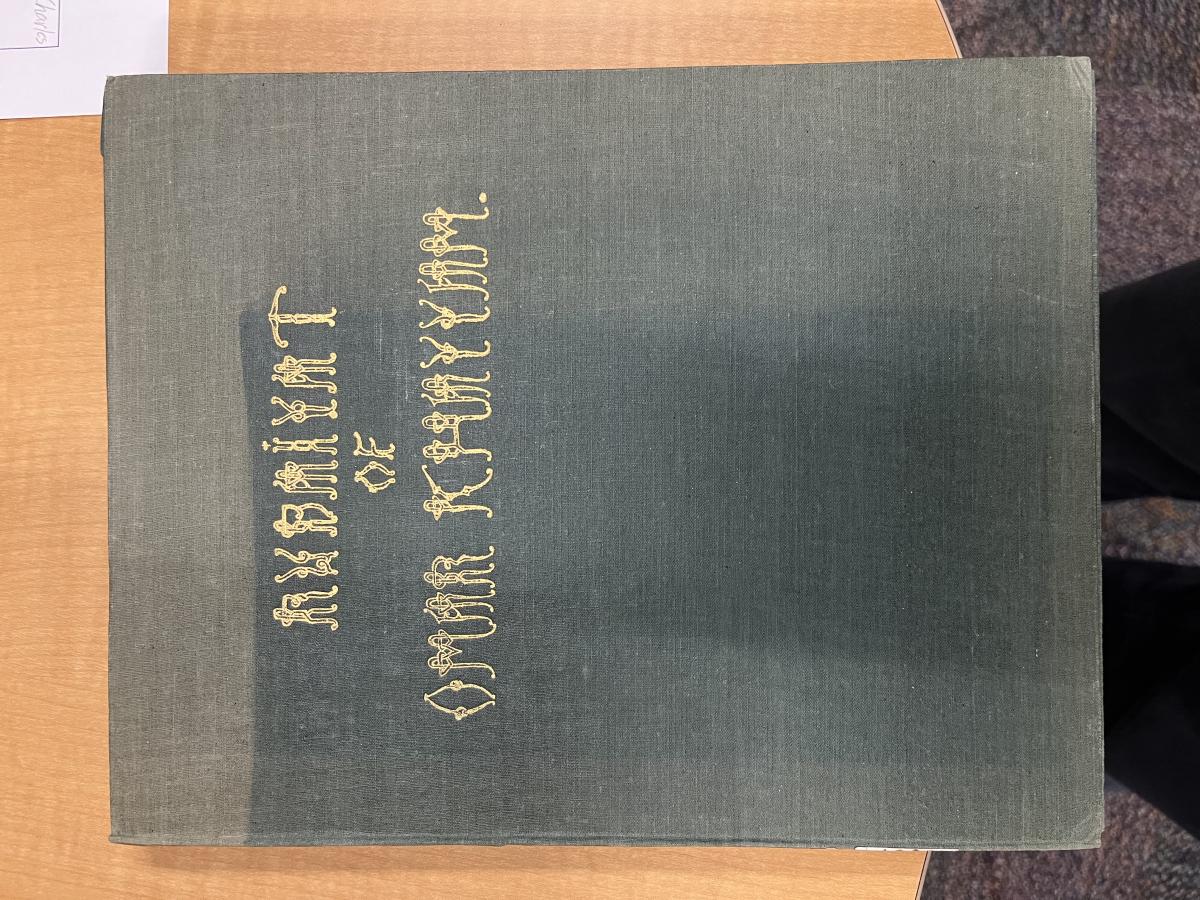This gift book edition of Rubáiyát of Omar Khayyám is estimated to have been published around 1946 by D.B. Taraporevala Sons & Co. in Bombay, was translated by Edward Fitzgerald, and illustrated by M.K. Sett. This copy uses the first edition of Fitzgerald’s translation, and includes several ornate illustrations of two distinct styles—one with highly detailed red ink printed decorative borders around each stanza of the poem written in green handwritten printed text, and the other with thicker-lined, black and white ink print illustrations, often having many fragmentary elements together on one page (see figs. 3,4).
This edition is unique in the fact that there is no formal binding nor is there any evidence of previous binding—the 30 thick-stock, loose, illustrated pages are simply held in their place by three flaps extending off of the book’s hardcover, folding in to enclose the pages into the hardcover itself. The only binding present in this edition is the bound front matter of the book, being a separate entity from the illustrated pages of the poem.
The 12 pages of the bound front matter of this edition are held together by two slightly tarnished staples, and is made of thick stock paper with a rather standard serif text printed throughout. Contained within a rectangular frame, the front page includes the name of the book as Rubáiyát of Omar Khayyám, followed by credit of illustration to M.K. Sett and what seems to be both an attribution of authorship and translation to Edward Fitzgerlad, as his introductory line states: “English Version By.” The front page also includes the name of the publisher, followed by the publisher’s address located in Bombay (present day Mumbai). In small text just outside the rectangular frame, the price is listed as twelve rupees (see fig. 1).
Inside this bound front matter is a publisher’s note, an introduction, and a full copy of the first edition of the poem to come without any illustrations. The Publisher’s Note on the first page praises the work of the illustrator M.K. Sett, stating that he has “a great reputation as an artist in Europe,” and includes a personal account of satisfaction with Sett’s work from the poet Rupert Brook. The following Introduction, written by Sett, speaks of the “abysmal depth” the art world has fallen into due to the destruction of high and middle class distinctions from “two two global wars.” He also addresses the question of whether he draws inspiration from illustrator Aubrey Beardsley, by stating that he didn’t know of his work until “quite recently,” and explains his illustrative style as drawing from “the usage of the East,” yet maintaining “a dash of the west.” Following, are explanations of each black and white image, and what they are meant to resemble—an inclusion that seems to align with the general distrust Sett expresses in the degraded artistic interpretative skills of the public.
Immediately following the front matter is an opening page of the illustrated portion of the edition, with similar information presented such as the title, illustration credit, and publisher name, with the only difference being that the poem’s authorship is unambiguously credited in full to Edward Fitzgerald (see fig. 2).
Speaking to the illustrations themselves, what is especially compelling is not only the detail included, but the rather abrupt switch from red and green ink prints to the black and white fragmentary illustrations. While the green and red illustrations appear first and accompany the entirety of the poem, the black and white images only illustrate particular, selected stanzas of the poem that appear on the backs of the illustrated pages (see fig. 4, 5). This element also seems to speak to the high class/fine taste audience Sett is attempting to re-establish within the art world, as this makes the book a highly decorative and elaborate gift book.







